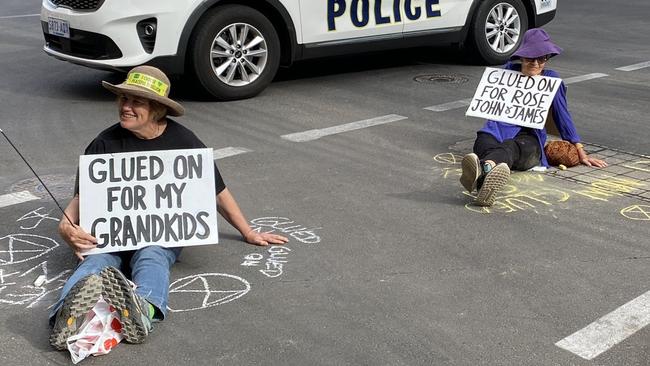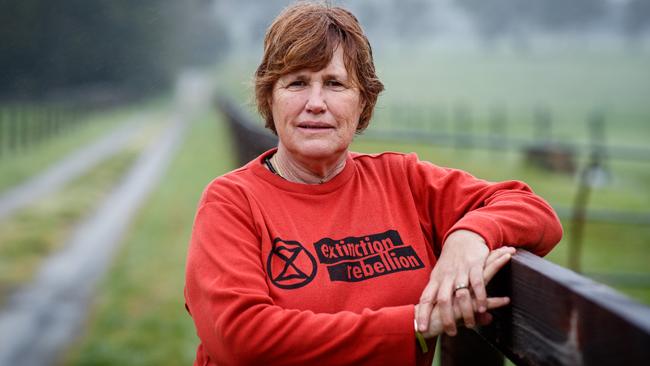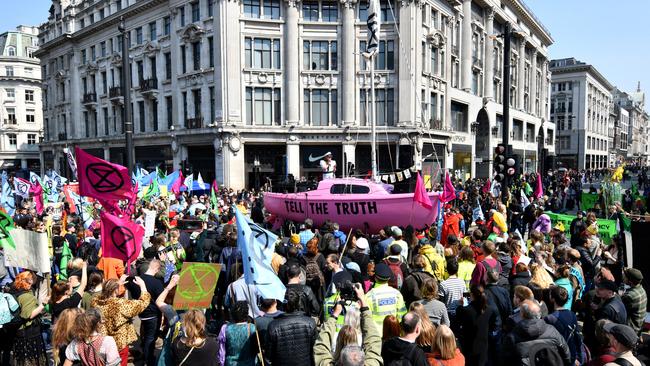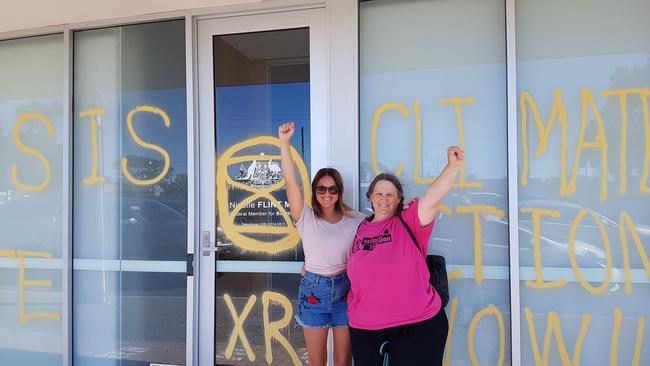Who is Extinction Rebellion and why are they glueing themselves to Adelaide streets?
Extinction Rebellion has made headlines all over the world with its tactics of civil disobedience and mass arrests. It’s Adelaide arm is diverse, including previously law-abiding grandmothers who are happy to be locked up in the name of climate change.
SA Weekend
Don't miss out on the headlines from SA Weekend. Followed categories will be added to My News.
The prison guards in the Adelaide City Watch House kept asking the question. “Why did you do this?” Some were polite, some more aggressive, adding, “you’re so stupid”. Cate Mettam, locked up for the first time in her life, kept replying “no comment” to all the inquiries, until eventually she could contain herself no more.
“Because there is no other option,” she told them.
The 66-year-old Mettam – mother to three, grandmother to five – had just been arrested for gluing herself to Flinders St, the road which runs past the headquarters of the oil and gas company Santos. As Mettam sat there, with a sign that read “Glued on for my grandkids’’ she knew it was likely the day would end in a jail cell.
But that was OK. That was partly the point.
Mettam is part of Extinction Rebellion, a global environmental movement that began in England in 2018, that aims to shift governmental and corporate policies on climate change.
Among Extinction Rebellion’s “demands” are that “governments must tell the truth by declaring a climate and ecological emergency” and that they “reduce greenhouse gas emissions to net zero by 2025”.

It is estimated there are around 485 Extinction Rebellion groups in 70 countries, with about 200 active members in South Australia, including Mettam. But how does a 65-year-old retired public servant end up with her left hand glued to Flinders St?
Mettam lives in the Adelaide Hills. She has always been interested in the environment. Then the 2019 fires roared through great swathes of the Hills. They didn’t reach her property but were close enough to leave ash and embers around the house. It was an event that solidified her determination that she had to do something about climate change. Her grandchildren who were staying with her at the time were evacuated. “How many times can you have the east coast burn or the Adelaide Hills burn?’’ she asks.
Mettam had previously seen a story in her local paper about a local Extinction Rebellion group and made contact. At first it was relatively straightforward tactics. Banners were painted and displayed by roadsides. Extinction Rebellion held a protest in the city in late 2019 at the intersection of Pulteney and Rundle St with a few hundred activists that stopped traffic.
But, as with everything, Covid got in the way and plans for further mass protests were disrupted. It was not until March this year that the plan to draw attention to Santos was carried out. Of particular concern to Extinction Rebellion was the federal government’s approval in late 2020 to allow Santos to proceed with the $3.6bn gas project in Narrabri in New South Wales, which would involve up to 850 gas wells being drilled.
“We thought we must let people know that Santos is a problem in South Australia and we can do something about that,” Mettam says. But she also knew they had to do something a bit different to be noticed by the media. That it couldn’t be “just a bunch of old ladies holding banners”.
“We decided to do something, which was pretty insane really, glue ourselves to the road. We’ve used chains before and they have just cut the chains off. We thought glue is probably going to be different.”

But that was only part of the protest. Other Extinction Rebellion members scaled the building and hung banners off the Santos building proclaiming “Your Gas is killing us”. Others used spray chalk to write “net zero carbon emissions by 2025” on its glass front.
Six people were arrested as traffic was disrupted for several hours through the middle of the city.
Mettam, who hadn’t told her family what she was doing that day, was glued to Flinders St for more than three hours, finally released by acetone and a combination of police and paramedics. She was placed in the back of a police van and taken to the watch house to be charged with loitering.
Perhaps, unsurprisingly, it was her first time in a jail cell. But Mettam was at least somewhat prepared. She had spoken to someone who had been in a cell before and they had told her they had passed the time by singing. So that is what she did.
Turns out there is an official Extinction Rebellion song book. Mettam worked through songs such as It Isn’t Nice, which goes something like: “It isn’t nice to block the courtroom. It isn’t nice to go to jail. There are nicer ways to do it. But the nice ways always fail. It isn’t nice, it isn’t nice, you told us once, you told us twice, but if that’s survival’s price we don’t mind.”
In a cafe in Hahndorf, Mettam gives a quick rendition of the ditty. She was only in the cell a few hours before being bailed, but the fact she was willing to be arrested in support of her views demonstrates the commitment of many Extinction Rebellion members.
Being arrested is part of the Extinction Rebellion battle plan. The movement was founded in 2018 by a group of activists including one called Roger Hallam, who had previously organised against air pollution with a group called Stop Killing Londoners and had started a hunger strike which led to Kings College, London, selling its investments in fossil fuels.
But Hallam also had a bigger idea. That mass arrests would force the government to listen to protesters.
Explaining his idea to The Guardian in Britain, Hallam predicted: “Within a year or so we will have thousands of people on the streets, blocking large parts of central London for days on end. Hundreds will be arrested and the government will be forced to sit down and tell the truth about the climate emergency.”
Extinction Rebellion was launched in October 2018 with a letter signed by 500 academics and scientists which said, in part: “The science is clear, the facts are incontrovertible, and it is unconscionable to us that our children and grandchildren should have to bear the terrifying brunt of an unprecedented disaster of our own making.”
The next month Extinction Rebellion held a protest which blocked five bridges in central London. It was the following April that the group’s philosophy was really put into practice. Over 10 days, Extinction Rebellion protesters blocked London landmarks such as Marble Arch, Oxford Circus, Waterloo Bridge, Piccadilly Circus and Parliament Square. They also glued themselves to trains and the stock exchange, staged “die-ins” and marched to Heathrow Airport. Swedish activist Greta Thunberg was there and celebrities including actor Emma Thompson showed up in support. More than 1100 protesters were arrested. One of the central tenets of Extinction Rebellion is all this civil disobedience must be non-violent. There are training courses for protesters in what is and what is not acceptable.

Ben Brooker is the Adelaide spokesman for Extinction Rebellion. Brooker is 37 and about to become a father for the first time, a factor which he says has even further pushed his dedication to doing something about the climate crisis. A freelance journalist and playwright, Brooker says he’s always had a consciousness about the environment and has a strong memory of the McDonald’s “McLibel” case of the 1990s, which became the longest-running legal action in British history when the fast food company sued two activists who had been distributing pamphlets criticising the company’s environmental and health record.
“I was probably 12 or 13 and I just had this incredible sense of, ‘Oh my God it’s so wrong’ but these two activists, ordinary people with no resources behind them … were being kind of stamped on by this huge corporation and their lawyers,” he says.
Brooker says part of the reason he joined Extinction Rebellion was he didn’t believe the old methods of protest were working anymore. He cites the massive protest marches against the Iraq war in 2003.
“I think that was a real wake-up call actually about the failure of electoral politics because, of course, protests around the country make no difference,” he says.
“We went to war anyway. And you know all the consequences that we feared at that time, they have since come true and it’s kind of interesting and it’s tragic that 500,000 Iraqis are dead now.”
Brooker joined Extinction Rebellion in early 2019 after seeing some of the early protests in London. He joined a local group of around 10 fellow activists. One of the unusual aspects of Extinction Rebellion is that it has no formal centralised structures. They gather in what are called “affinity groups”. Those that want to protest under the group’s banner have to abide by the group’s 10 “values”, which include statements such as “we have a shared vision of change”, “we openly challenge ourselves and this toxic system” and “we avoid blaming and shaming”.

From there each individual group can decide what action best suits their own situation.
Brooker says joining the rebellion has been “a great release valve for my own anxiety about climate change”.
He says non-violent, civil disobedience is at the heart of the Extinction Rebellion approach. “That’s the only thing that really works,” he says, pointing to the examples set by Indian independence leader Mahatma Gandhi and US civil rights activist Martin Luther King Junior.
Brooker knows that there are plenty who resent the Extinction Rebellion approach. It has been criticised in the media and by those annoyed at being stuck in traffic when the group takes over roads as it did in Adelaide.
But he believes, in the long run, Extinction Rebellion will be proved right. That its actions will fall on the right side of history.
“I’m not for a second saying we are Gandhi or Martin Luther King, but what I am saying is that I think in 30, 40, 50 years, people will look back on this moment and I think they will have a different sense of how important the work is that we’re doing.”
Brooker says the group understands they make some people angry but at the very least the controversy creates discussion.
“Ultimately the reason we’re doing this is to protect the future,” he says. “To protect the irreplaceable wilderness, to protect our right to a hospitable planet. And so, you know, we think that (the disruption) that’s a small price to pay.”
One who doesn’t agree is outgoing federal Liberal MP Nicolle Flint. Flint’s office has been targeted by the group a number of times. Flint’s Anzac Highway office was graffitied with slogans such as Climate Action Now in washable spray chalk.
“I’ve got absolutely no problem with peaceful protests, but there’s nothing peaceful about it,” Flint says. When, shortly after the demonstration Flint announced she was quitting politics, she namechecked Extinction Rebellion as one of the reasons for her decision, as well as intimidation from a variety of groups when campaigning during the 2019 federal election.
Explaining her decision to quit parliament, Flint said: “I have tried hard to contain my emotion at my decision to leave the parliament at the end of this term, especially when explaining the reasons. Recounting, yet again, the treatment I suffered at the hands of GetUp, Labor and Extinction Rebellion, and the dangerous behaviour their actions have encouraged, is hard.”
The MP told SAWeekend she and her staff felt vulnerable because they didn’t know how far the protesters would go.
“They’re banging drums and shouting and chanting and things like that and when that is immediately in front of your electorate office, which is all glass, I mean who knows what happens next? It’s not hard for someone to put a rock through a window or who knows what they had.
“It’s just the threat and I suppose that’s what they’re trying to achieve, which is to really intimidate people.”

Brooker rejects the claim that the protesters were intimidating.
“It was never a personal campaign,” he says, pointing out they had demonstrated at other MPs offices, such as Finance Minister Simon Birmingham.
“We target politicians where we feel they’re failing to do what’s necessary to address the climate crisis.”
Brooker says he was also unhappy that Flint had rolled the actions of Extinction Rebellion into her broader critique of sexism in politics.
“We felt (that) was totally unjustified in our case, because of course you know it should go without saying that XR very much sees all these struggles are interconnected; classism, racism, sexism, environmentalism, they’re all indistinguishable to us.”
One outcome of the confrontation between Flint and Extinction Rebellion has been a toughening in legislation through the Electoral Legislation Amendment (Electoral Offences and Preventing Multiple Voting) Bill 2021.
Under the legislation: “Violence, obscene or discriminatory abuse, property damage and harassment or stalking are examples of conduct that may be an offence under this subsection.” A conviction carries a penalty of up to three years or a fine of up to $22,200.
Flint says the new laws will “capture ER and all the other rubbish I had to put up with at the last election”, although how it will work in practice is still an unknown.
At the University of South Australia, Adam Simpson is senior lecturer in international studies who has examined environmental politics. Simpson says Extinction Rebellion is taking a different tack to some of the more established environmental groups such as the Australian Conservation Foundation and the Wilderness Society. He says their tactics are more akin to more visible actions of organisations such as the Occupy and Lock the Gate movements, which also employ social disruption strategies.
“The main difference is that Lock the Gate activities often take place in rural or remote areas, since they are often focused on a particular mine or project, while XR take their campaigns to the centre of cities since they are seeking broader political and societal change,” Simpson says.
And while this may annoy some sections of society, Simpson says its campaigns and strategies means the Extinction Rebellion message is being heard.
“Their tactics have received significant media coverage which has allowed them to communicate their message of urgent societal change to a wide audience,” he says.
Extinction Rebellion is likely to become even more active as the threat of Covid hopefully recedes when the nation hits its vaccination targets.
Mai Nguyen is committed to keeping the protest going. The 33-year-old community services worker has already been arrested twice for her Extinction Rebellion activism. Once for climbing the Christmas tree in Victoria Square and hanging banners saying “Goodwill to Earth” and “Climate Peace”.
The second was at the Santos protest when she used a ladder to climb on top of the awning out front of the company’s building, drape more banners and glue herself to the roof.
Nguyen was part of a group within Extinction Rebellion that called itself “Keep a Rebel Laughing Amigos” or Karla. Nguyen says Karla started because she was “getting a bit bored with the banner drops and the singing in the Mall”.
“I thought, I’m spending a lot of energy just to sing, I’d rather direct this energy somewhere else,” she says. Nguyen was keen on causing a bit more disruption, a little more chaos that would spread the Extinction Rebellion word faster.

And regardless of what people may think of her methods, Nguyen is unswerving in her devotion to the cause. She has told her work about her membership of Extinction Rebellion, including the arrests, and they are comfortable so far, but Nguyen is prepared if the time comes when that changes. While Nguyen has twice seen the inside of the Adelaide City Watchhouse, no convictions have as yet been recorded.
“I’m not really concerned with what happens to myself,” she says. “I’ve accepted that, to engage with this, you might lose your job.”
Which is not to say Nguyen is oblivious to the effect her actions have on other people – those stuck in their cars by a protest, or washing the spray chalk off windows. It’s just that she thinks what Extinction Rebellion does is necessary to help push what she says is the urgent message on climate change.
“I feel like we don’t have that much time left and I’m willing to give anything a go that’s not violent,” she says.
“I feel unhappy for the people who get caught in it. I sympathise with the people that get stuck. But at the same time, what’s the bit of disruption in comparison to how disruptive it would be if we’re all on fire.”
Being arrested hasn’t slowed down Cate Mettam either.
The loitering charge from the Santos demonstration was dropped, then she was arrested again, this time in Tasmania where she was protesting logging in the Tarkine forest.
Mettam says she is quite willing to be arrested again.
“I never thought I’d be doing something like that,” she says. “Why would someone like that willingly put themselves in danger on a road, allow the police to arrest them and have no idea what that outcome would be – because we didn’t.”
The answer to Mettam is simple.
“This is the big existential crisis.”




